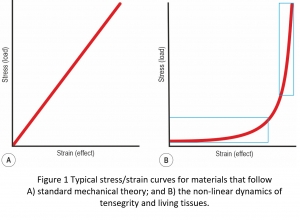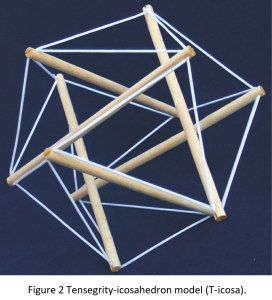Biotensegrity: What is the big deal?
Journal of Bodywork and Movement Therapies 2020, 23: 134-137 link
Graham Scarr Request copy
Fascia science and clinical applications: Editorial
1. The conundrum Biotensegrity is currently a hot topic amongst many of those who practice within the field of ‘bodywork and movement therapies’, and for good reason. It fits with the ethos that unites a wide diversity of different practitioners and therapeutic methods because it intrinsically recognizes the wholeness of the human body. In other words, that an appreciation of the interconnectedness between every part of the organism is essential to a proper understanding of its functions and health (Still, 1899; Hohenschurtz- Schmidt, 2016).
Biotensegrity is also gaining momentum within the scientific community who examine the dynamic behaviour of cells and their interactions with the surrounding extracellular matrix and fascia (Ingber et al 2014; Reilly and Ingber, 2018), thus increasing our understanding of cancer and other illnesses (Tadeo et al 2014). It underpins new ideas about joint mechanics (Levin and Madden, 2005; Hakkak et al 2015) and the global connectivity between these tissues and the nervous system, all of which operate synergistically in controlling movement and are far more than collections of anatomical ‘bits’ (Profeta and Turvey, 2018; Cabe, 2019).
Biotensegrity has influenced the development of robots destined for the exploration of space (Caluwaerts et al 2014) and new classes of joint and prostheses with potential medical applications (Lessard et al 2016). It inherently recognizes that complex living structures are the result of interactions between some basic principles of self-organization, and that Nature’s ‘strategy for design’ is already contained within the dynamic architecture of the system. From the biotensegrity perspective, each ‘part’ is examined in relation to the whole and a more complete understanding obtained (Levin, 2016; Martin, 2016; Scarr, 2018).
This view, however, has long been at odds with mainstream scientific thinking that takes the ‘top-down, bottom-up’ approach. Where the dynamic body is typically reduced to a collection of ‘bits’ before being re-assembled according to the contrived workings of man-made machines from the Seventeenth Century (Borelli, 1680; Vogel, 2013). Where fundamental physical principles are generally overlooked because they are “too simple”, and multiscale anatomical continuities glossed over because they are “too complicated” (Kurakin, 2009; Saetzler et al 2011; Noble, 2017). ‘Biotensegrity’ is different because it examines those basic rules of physics first and recognizes that everything else must be derived from them, thus representing a paradigm shift in the way that we think about the human body.
However, before running away with our enthusiasm we must recognize that many scientific researchers – and even some of those ‘bodywork and movement therapists’ – are unconvinced about its value and relevance; or are simply too busy with other things (Ingber et al., 2000). There are also others who intuitively recognize that biotensegrity fits with the holistic view of the human body but are puzzled about how to meaningfully use or apply it. It is also clear that misinformation abounds and that there are many misconceptions of what it is. Which thus brings us to ask the obvious question: What is biotensegrity? but for which there is no simple answer because it all depends …
Such a question clearly starts from the position of the person who is asking it: their current understanding of the term and what they really want to know, and why, and everyone begins from a different place. If biotensegrity really does embody those underlying principles of biological organization and movement, as its proponents claim, then there is much to be explained; but where do we begin?
We could describe standard models of biomechanics – lever theory, linearization (Vogel, 2013) and the inverted pendulum (Hatze, 2002) – and then explain what is disturbing about them; detail the simple rules, geometry and tensegrity models that provide a more complete appreciation of complex anatomical organization; or just explain the difference between ‘tensegrity’ and ‘biotensegrity’, because they are not necessarily synonymous. We could examine the global continuity between the cellular cytoskeleton, extracellular matrix and fascia etc. (Ingber et al 2014), and explain why bone is considered part of the latter (Bordoni and Lagana, 2019; Levin, 2018a,b); describe the geometry of motion, or rather, the closed kinematic chain system that pervades the entire body at every size-scale and enables forces, power and information to be transferred from one region to another in a controllable way (Levin et al 2017). We could also offer multiple anatomical examples for how biotensegrity provides a more complete explanation of normal and ‘abnormal’ joint function than is currently available. Look at small-world networks, systems science, soft-matter, non-linearity, auxetics, embryological development and the biotensegrity algorithm, and so on (Levin, 2016, 2018a,b; Scarr, 2018).
The question of where to start is thus different for each person according to their own interests, preferences and inclination, but we must not forget that we are ultimately dealing with biology, where no one aspect can be fully understood without an appreciation of all the others. Biotensegrity deals with all these things because it is an overriding concept; a field of enquiry that examines the globality of living forms through first principles, and it is not limited by a simple definition; but another question now arises. What is the problem with things as they stand?
2. The age-old problem Anatomists have always classified structures according to the thinking of the day and used the latest technologies to better understand their functions, but established conventions have allowed many inconsistencies to survive long past their sell-by date. Standard biomechanical theory, for example, remains rooted in the behaviour of inanimate objects and man-made machines from the Seventeenth Century (Borelli, 1680; Vogel, 2013), but living organisms are not constrained by the same set of rules.
 Robert Hooke (1635e1703) discovered that the relationship between stress and strain for an elastic material is a linear one (Fig. 1A), yet living tissues display a non-linear curve (Fig. 1B). In order to avoid this inconvenience, modern biomechanics has taken the more ‘vertical’ high-stress/strain part of the curve to be a straight-line, because this simplifies their equations and analysis, but it is a fudge! “True linearity does not exist in biology – not even as an approximation. Such a living system that is so profoundly complex at all its different levels and size-scales (109 -102 m) cannot behave in a linear way, it is fundamentally impossible” (Blyum, in press).
Robert Hooke (1635e1703) discovered that the relationship between stress and strain for an elastic material is a linear one (Fig. 1A), yet living tissues display a non-linear curve (Fig. 1B). In order to avoid this inconvenience, modern biomechanics has taken the more ‘vertical’ high-stress/strain part of the curve to be a straight-line, because this simplifies their equations and analysis, but it is a fudge! “True linearity does not exist in biology – not even as an approximation. Such a living system that is so profoundly complex at all its different levels and size-scales (109 -102 m) cannot behave in a linear way, it is fundamentally impossible” (Blyum, in press).
It is much more likely that biological structures function within the more ‘horizontal’ low-stress/strain region where they will be more responsive, consume less energy and operate more efficiently. This would then make the stress/strain ratio used in most biomechanical research – Young’s Modulus – virtually meaningless because it will be different at each point along the non-linear curve. In addition, the origin of the curve never reaches zero stress because of the intrinsic tension contained within the system (Masi and Hannon, 2009; Schleip and Klingler, 2019). It should be pointed out that the dynamics of tensegrity structures are quite similar to living tissues in that they also behave non-linearly and are incredibly complicated to analyze mathematically (Caluwaerts et al 2014) etc; and there is another important point to make.
Synovial joints are widely considered to act as levers – cranes, wheelbarrows and see-saws etc – as described by Borelli (1680), but the problem with levers is that they generate bending moments, shear stresses and other potentially damaging stress concentrations. While man-made constructs are engineered to contain shear-stresses within the particular design, it is likely that they would cause material fatigue and collapse if they appeared within developing tissues, and that would really be the end of them (Levin, 1995). Levers also imply that bones must be compressed across their articular surfaces, yet it has been shown that normal joint surfaces in the knee are not compressed, even when they are pushed together (Terayama et al., 1980; Levin and Madden, 2005; Hakkak et al 2015).
Current biomechanics does not have a theory to explain how synovial joint surfaces could be held apart, or decompressed, but biotensegrity does and the reader is referred elsewhere for further information (Levin, 2016; Martin, 2016; Scarr, 2018). There is nothing wrong with classical mechanics but it is important to note that its application to biology is mostly contrived and out of date (Levin, 1995; Sharkey, 2015).
Most biomechanical research ignores these issues because it is able to manipulate the conditions of the experimental system in a way that can produce any result that is desired (Scarr and Harrison, 2016). When it finds an answer that appears to match reality it then assumes that biology operates in the same way; but this is a questionable strategy (Kurakin, 2009; Noble, 2017). Perhaps more a case of getting the right answers for the wrong reason?
It is now becoming clear that many researchers recognize these problems but until relatively recently there has been no real alternative. Biotensegrity now looks at structural biology from a different perspective and it is already making a difference …
3. Therapeutic practice It is not the main purpose of this article to ravage traditional views but to introduce the relevance of biotensegrity to those who may be unfamiliar with what it is. However, we are all heavily steeped in standard mechanical theory, where our education has taught us that the elbow operates as a hinge joint and third-class lever, and that the body is a collection of anatomical bits and operates like a machine. Such views have become embedded within our thoughts and language and must inevitably influence what we do. We may or may not be aware of them but they are always there; which then brings us to a new raft of questions. How is biotensegrity useful to bodywork and movement (or any other) therapy? How can it be applied and why should we care?
At one level, of course, it doesn’t matter. If a practitioner is content and satisfied with what they are already doing then there may be no need for all this academic stuff – the results will speak for themselves. At another level it does matter because we want to improve what we do and provide the best care for our patients/clients. If a biotensegrity perspective can offer something beneficial to our understanding of the human body and therefore clinical/movement practice, why would we not want to find out more?
However, here again lies a conundrum because there is no simple ‘learn this – apply that’ protocol. There are no prescriptive exercises or techniques because that is NOT what biotensegrity is about; and disappointing though that may be, it is time to immerse ourselves in the bigger picture and make it relevant to practice.
What biotensegrity does is offer a different way of examining the human body in the light of new understandings about functional anatomy, and because it is based on the rules of physics first it is worth paying attention to. It is an overriding concept that describes a relationship between every part of the organism and the mechanics that integrate them into a complete functional unit. A fully integrated, dynamic and efficient principle of structural organization that extends from the smallest of molecules to the complete organism.
In other words, biotensegrity relates to real-life biology and every effort to understand it better, and that includes the knowledge that informs what we do in everyday practice. It starts from first principles and provides the basics that change how we think about the human body, but each person must find their own way of ‘applying’ it.
 Tensegrity models are the key because their physical behaviour is similar to living tissues in many ways, and making your own is the best way to appreciate them (Fig. 2). They turn the theory into something tangible. “Models have always played an important part in clinical practice and provide the practitioner with a conceptual tool that can be used in both diagnostic and therapeutic reasoning (Hohenschurtz-Schmidt, 2016). Tensegrity models reveal the forces that are active within them, the geometric organization that underlies all living structures and the functional mechanics that emerge from within it” (Scarr, 2018).
Tensegrity models are the key because their physical behaviour is similar to living tissues in many ways, and making your own is the best way to appreciate them (Fig. 2). They turn the theory into something tangible. “Models have always played an important part in clinical practice and provide the practitioner with a conceptual tool that can be used in both diagnostic and therapeutic reasoning (Hohenschurtz-Schmidt, 2016). Tensegrity models reveal the forces that are active within them, the geometric organization that underlies all living structures and the functional mechanics that emerge from within it” (Scarr, 2018).
The biotensegrity concept looks at morphological complexity through the geometry of its architecture and appreciates this as an energy-efficient mechanism that has refined itself over hundreds of millions of years. A constantly evolving information processing system that enables each part to move with the minimum of effort and powers the dynamism that we recognize as life. Biotensegrity describes the basic science that underpins what every practitioner does but from a new and more integrated perspective, and that is what makes it a Big Deal.
References
Blyum, L., 2020. The unreasonable effectiveness of light touch. In: JE Trewartha, SL Wheeler eds., Scars, Adhesions and the Biotensegral Body: Science, Assessment and Treatment. Edinburgh, Handspring.
Bordoni, B., Lagana, M.M., 2019. Bone tissue is an integral part of the fascial system. Cureus 11, e3824.
Borelli, G.A., 1680. De Motu Animalium. Lugduni Batavorum, Petrum Vander as.
Cabe, P.A., 2019. All perception engages the tensegrity-based haptic medium. Ecol. Psychol. 31 (1), 1e13.
Caluwaerts, K., Despraz, J., Isçen, A., Sabelhaus, A.P., Bruce, J., Schrauwen, B., SunSpiral, V., 2014. Design and control of compliant tensegrity robots through simulation and hardware validation. J. Roy. Soc. Interface 11 (98), 20140520.
Hakkak, F., Jabalameli, M., Rostami, M., Parnianpour, M., 2015. The tibiofemoral joint gaps – an arthroscopic study. SDRP J. Biomed. Eng. 1 (1), 1e6.
Hatze, H., 2002. The fundamental problem of myoskeletal inverse dynamics and its implications. J. Biomech. 35, 109e115.
Hohenschurtz-Schmidt, D., 2016. Tensegrity and manual therapy practice: a qualitative study. Int. J. Osteo. Med. 21, 5e18.
Ingber, D.E., Wang, N., Stamenovi_c, D., 2014. Tensegrity, cellular biophysics and the mechanics of living systems. Rep. Prog. Phys. 77 (4), 046603.
Ingber, D.E., Heidemann, S.R., Lamoureux, P., Buxbaum, R.E., 2000. Opposing views on tensegrity as a structural framework for understanding cell mechanics. J. Appl. Physiol. 80, 1663e1678.
Kurakin, A., 2009. Scale-free flow of life: on the biology, economics and physics of the cell. Theor. Biol. Med. Model. 6 (6), 1742e4682.
Lessard, S., Castro, D., Asper, W., Chopra, S.D., Baltaxe-Admony, L.B., Teodorescu, M., SunSpiral, V., Agogino, A.K., 2016. A bio-inspired tensegrity manipulator with multi-DOF, structurally compliant joints. IEEE/RSJ Int. Conf. Intell. Robots Syst. (IROS) 9th – 14th October Daejeon Korea. https://doi.org/10.1109/ IROS.2016.7759811.
Levin, S.M., 1995. The importance of soft tissues for structural support of the body. Spine: State of the Art Rev. 9 (2), 357e363.
Levin, S.M., 2016. Tensegrity: the new biomechanics. In: Hutson, M., Ward, A. (Eds.), Textbook of Musculoskeletal Medicine, 2nd edition. Oxford University Press, Oxford.
Levin, S.M., 2018a. Bone is fascia. Available Online at. https://www.researchgate.net/ publication/327142198_Bone_is_fascia.
Levin, S.M., 2018b. The biotensegrity algorithm. In: G. Scarr Biotensegrity: the Structural Basis of Life, second ed. xiii-xv Edinburgh, Handspring.
Levin, S.M., Lowell de Solorzano, S., Scarr, G., 2017. The significance of closed kinematic chains to biological movement and dynamic stability. J. Bodyw. Mov. Ther. 21, 664e672.
Levin, S.M., Madden, M.A.. In vivo observation of articular surface contact in knee joints. Unpublished. Available at: www.biotensegrity.com.
Martin, D.C., 2016. Living Biotensegrity: Interplay of Tension and Compression in the Body. Keiner, Munich.
Masi, A.T., Hannon, J.C., 2009. Human resting muscle tone (HRMT): narrative introduction and modern concepts. J. Bodyw. Mov. Ther. 12 (4), 320e332.
Noble, D., 2017. Dance to the Tune of Life: Biological Relativity. Cambridge University Press, Cambridge.
Profeta, V.L.S., Turvey, M.T., 2018. Bernstein’s levels of movement construction: a contemporary perspective. Hum. Mov. Sci. 57, 111e133.
Reilly, C.B., Ingber, D.E., 2018. Multi-scale modeling reveals use of hierarchical tensegrity principles at the molecular, multi-molecular, and cellular levels. Extrem. Mech. Lett. 20, 21e28.
Saetzler, K., Sonnenschein, C., Soto, A.M., 2011. Systems biology beyond networks: generating order from disorder through self-organization. Semin. Cancer Biol. 21 (3), 165e174.
Scarr, G., 2018. Biotensegrity: the Structural Basis of Life, second ed. (Edinburgh, Handspring).
Scarr, G., Harrison, H., 2016. Resolving the problems and controversies surrounding temporo-mandibular mechanics. J. Appl. Biomed. 14, 177e185.
Schleip, R., Klingler, W., 2019. Active contractile properties of fascia. Clin. Anat. https://doi.org/10.1002/ca.23391.
Sharkey, J., 2015. Letter to the Editor. J. Bodyw. Mov. Ther 19, 391.
Still, A.T., 1899. Philosophy of Osteopathy. Kirksville MO, (self-published).
Tadeo, I., Berbegall, A.P., Escudero, L.M., Alvaro, T., Noguera, R., 2014. Biotensegrity of the extracellular matrix: physiology, dynamic mechanical balance and implications in oncology and mechanotherapy. Front. Oncol. 4, 39.
Terayama, K., Takei, T., Nakada, K., 1980. Joint space of the human knee and hip joint under a static load. Engin. Med 9, 67e74.
Vogel, S., 2013. Comparative Biomechanics: Life’s Physical World. Princeton University Press, Oxford.
